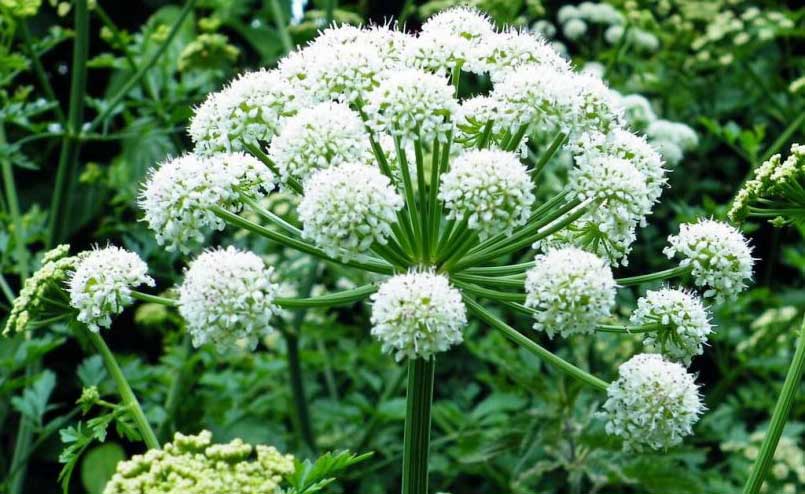Angelica Root
Other Names
archangel, masterwort, ground ash, holy ghost root, archangel root, dong quai, root of the holy ghost
A member of the parsley family, Angelica has large divided leaves of bright, glossy green and a thick stem, which is hollow and ridged. Grows to 3-8 feet tall.
This plant can be confused with water hemlock, which is a deadly poison, or hogweed, which causes photodermatitis with just a touch. Be careful if wildcrafting.
Propagation
Angelica is a biennial herb that prefers rich, moist soil and partial shade, like one would find in a swampy area. If it gets too much sun, mulching will help. It grows best in northern regions where there is a cooler period during the winter and the summers aren’t so hot.
Angelica will self-seed. The seeds are only viable for a few months, so it’s best to let this happen or reseed them yourself quickly. The plant produces a long taproot, so be sure to transplant seedlings while they are still quite small.
Angelica and dill are not good companions.
History and Folklore
Believed to have originated in Syria, angelica is now found just about everywhere. In ancient times it was used to ward off the plague and evil and as a cure for poison and… well, just about everything else.
It is believed that the plant’s name was derived from the fact that, according to the old calendar, it usually came into bloom around the feast day of the Archangel Michael, who appeared in a vision to explain the plant’s protective powers against evil.
Harvesting & Storage
You should cut stems for crystallizing before midsummer. Select healthy green stems about the thickness of a pencil.
The leaves are best harvested before the flowers appear and the seeds can be collected as soon as they ripen in late summer of the second year. If you’re using the root, you should harvest it in the autumn of the first year.
The leaves and roots can be dried and the stems can be crystallized.
Household Use
The dried seed-heads are attractive in flower arrangements and the root has a wonderful aroma, which it holds for a very long time making it perfect for potpourri mixtures.
Magical Attributes
Angelica is aligned with the sun and the element of fire and sacred to Venus.
Angelica is commonly used for general protection, especially against evil spirits and hex-breaking as well as general blessing, and is especially useful for the defense of women.
Grow angelica on your property to protect your garden and home.
Angelica root can be carried alone or added to amulets to increase longevity and ward off illness and evil spirits. It has also been used as a talisman to increase luck in gambling.
The leaves can be added to baths and potions designed to remove curses or spells or they can be burned to banish evil in an area. Angelica is very useful in home and personal exorcisms.
Keep angelica in a white bag and charge it to protect your baby.
Smoking the leaves is said to increase clairvoyance and encourage visions.
Angelica is excellent in incense or oil mixes for exorcisms, healing, and protection. It is also used as a bath to remove curses placed on the individual and sprinkled around a home to protect the house and those within from baneful magic.
Healing Attributes
Angelica tea is useful for colic, gas, indigestion, hepatitis, heartburn, nausea, ulcers and various other digestive ailments. It is a good general tonic that strengthens the liver and improves general well-being and mental harmony and is good for chronic headaches, fevers and general body weakness as it improves circulation and increases energy.
Angelica has also been used to bring on sluggish menses, so it carries a miscarriage risk for pregnant women and should be avoided by them.
Externally, angelica can be used to cleanse wounds and promote healing.
Culinary Use
The leaf has a high sugar concentration and can be stewed with acidic fruits and used in other recipes to reduce the amount of sugar needed. The dried leaves are also great added to tea blends.
The stem can be crystallized and used as a garnish.
Additional Notes
Angelica should not be used by pregnant women as it encourages activity in the pelvic region and may cause miscarriage.
Because of its high sugar concentration, angelica should be used with extreme caution or not at all by diabetics.

